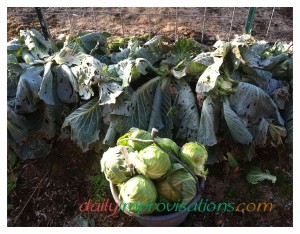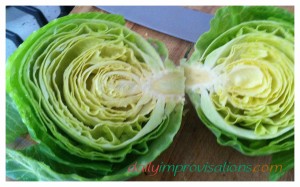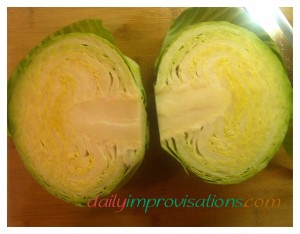This past year I planted three different kinds of cabbage in my southwest Idaho garden. I had actually purchased seeds for four types, but one kind never made it into the ground. Of the three that did get planted, there was an early season hybrid cabbage (Parel), an open pollinated mid-late season cabbage (Danish Ballhead), and a late season hybrid storage cabbage (Storage No. 4). We ate some of each and they all tasted like yummy garden sweet cabbage, but there were issues with crop size that may have been at least partially due to my not understanding my cabbages.
First, I didn’t pay enough attention to how large the early season Parel cabbage was supposed to get. I planted it in early spring and it sprouted promptly. The plants didn’t get very large, which surprised me precisely because I was picturing grocery store sized cabbage. Then, I saw the beautiful little heads form and I waited for them to get bigger. Since they were already full size at that point, they could only hold on so long before they cracked. What wasn’t my fault was that they seemed to be maturing during a wet spell AND as the aphids hit the countryside. The wet weather was perfect for other cabbage predators, too, so some mornings I would walk through the garden to find large chunks of cabbage missing from a head that had looked perfect the day before. Between all of this, I watched with disappointment as many of my first cabbages turned ugly. I am inclined to try the early cabbage again next year, but will make better notes to myself, at least mentally, about how big it will get. (click on any photo to enlarge)

Many of the Danish Ballhead cabbages are still out in the garden. This was again a case of me not understanding how the cabbage would grow. I kept going by and feeling the cabbage heads, but they never felt firm enough. Now, I see that they don’t get as dense as cabbages I am most familiar with, excepting Chinese cabbage, which grows in a different shape all together. These open pollinated cabbages don’t seem to have the same classic cabbage look as the hybrid plants. At least in my garden, they grew comparatively taller before forming the head. They also were forming more than one head per plant. This was confusing to me. I have had cabbages form a second head in the past, but not until the first was picked or well past it’s prime. These were also the cabbages that I planted the latest, so I want to give them another try with a better timetable. They are holding well out in the garden, which means I may get a better harvest from them yet now that I have a better idea of how to evaluate their maturity. Sometimes it takes a season to get to know a variety of any vegetable.



Storage No. 4 is not an overly creative name for a cabbage, but it gets the point across. I found the labeling stick for this row so know that I planted it directly into the ground on May 24th. This is a bit late to plant cabbage here in Idaho, but it has worked out reasonably. I still got a productive row of cabbage. One thing about the timing is that I had next to no trouble with aphids. I did spray the plants with insecticidal soap once or twice in July and that seemed to keep things under control.
We had only harvested 2-3 of them up until the last couple of days of November, though, and I thought I had missed the window of opportunity. There were many hard freezing temperature nights in November. I had picked one cabbage while it was still frozen on the stalk, to cook with a dinner, but figured the rest might not make it. I was wrong.
I went out a few days later and none of them looked at all frozen. Even though the night time lows had been in the mid 2o’s (°F), the day had warmed to about 40°F. By the afternoon, the cabbage heads had adjusted and could be cut and used, fresh and crisp. I was able to make coleslaw, for starters, and have plans for using another soon for tacos (substituting it for the lettuce). I am pretty pleased to be harvesting fresh greens from the garden as we turn the corner into December! I will also plan on trying my hand with sauerkraut again (sorry, Honey, I know it’s not your favorite), as well as see if a few of them will store in my basement pantry.

Maybe next year I will also get around to planting the fourth type of cabbage. What types of cabbage to you have success with?

Leave a Reply